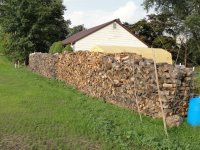From my limited first-hand testing:
- The most important thing to do is get the wood off the ground. Pallets are free if you know where to look, and will last at least a few years. (When I've piled or stacked on the ground, the bottom half of the stack or pile is wet and/or moldy)
- The next step is to promote airflow. Long rows of stacks, 1-2 rows wide will dry more quickly than piles, or multiple rows of stacks. Don't worry about stacking it tight, just make sure it's stable. (Stacked wood seasons in a year or so for me. Piles NEVER dry out, especially directly on the ground)
- I'm not all that worried about covering my stacks. I might put some big pieces of bark or something up there if I'm in the mood, but it doesn't really do anything. A well ranked stack will shed much of the rain that falls on it. The top couple pieces of wood might be a little wet during rain, but they dry out first, so in all, it seasons just as fast as the bottom of the pile, if not a little faster.
- T-posts are nice to stabilize the ends, but careful stacking can make them unnecessary. Use similar sized splits to build your ends up in an alternating criss-cross pattern, and key in every few layers to the larger stack, to stabilize.
I have seen people cover their piles or stacks, and when they open them up, it's nothing but mold and rot in there. Remember, the whole point of seasoning wood is to let the moisture OUT.


















